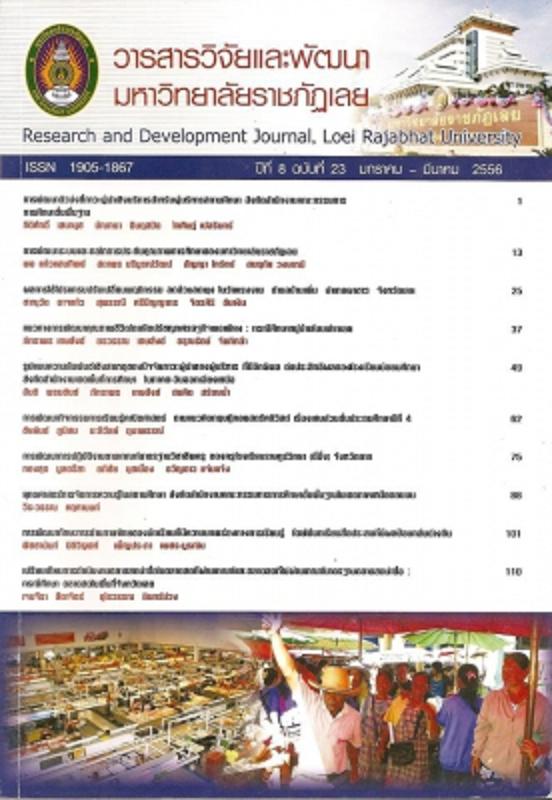รูปแบบความสัมพันธ์เชิงสาเหตุของปัจจัยภาวะผู้นำของผู้บริหาร ที่มีอิทธิพล ต่อประสิทธิผลของโรงเรียนมัธยมศึกษา สังกัดสำนักงานเขตพื้นที่การศึกษา ในภาคตะวันออกเฉียงเหนือ
Keywords:
ประสิทธิผลของโรงเรียน, ภาวะผู้นำของผู้บริหาร, school effectiveness, administrators leadershipAbstract
บทคัดย่อ
งานวิจัยครั้งนี้มีวัตถุประสงค์เพื่อ ศึกษาระดับของปัจจัยภาวะผู้นำของผู้บริหารและประสิทธิผลของโรงเรียน ศึกษาปัจจัยภาวะผู้นำของผู้บริหาร ที่มีอิทธิพลต่อประสิทธิผลของโรงเรียนมัธยมศึกษา สร้างรูปแบบความสัมพันธ์เชิงสาเหตุของปัจจัยภาวะผู้นำของผู้บริหารที่มีอิทธิพลต่อประสิทธิผลของโรงเรียนมัธยมศึกษา และตรวจสอบความสอดคล้องของรูปแบบความสัมพันธ์เชิงสาเหตุของปัจจัยภาวะผู้นำของผู้บริหาร ที่มีอิทธิพลต่อประสิทธิผลของโรงเรียนมัธยมศึกษากับข้อมูลเชิงประจักษ์ กลุ่มตัวอย่าง ได้แก่ โรงเรียนมัธยมศึกษา สังกัดสำนักงานเขตพื้นที่การศึกษา ในภาคตะวันออกเฉียงเหนือ ปีการศึกษา 2552 จำนวน 285 โรง ตัวแปรแฝง ได้แก่ ประสิทธิผลของโรงเรียนวัดจากตัวแปรสังเกตได้ 4 ตัว คือ 1) ความพึงพอใจในงานของครู 2) ความสำเร็จทางการเรียนของนักเรียน 3) ความสามารถในการแก้ปัญหาภายในโรงเรียน 4) ความสามารถในการปรับเปลี่ยนและพัฒนาโรงเรียน ตัวแปรที่มีอิทธิพลต่อประสิทธิผลของโรงเรียนมัธยมศึกษา 4 ตัว คือ 1) ปัจจัยด้านชีวทางสังคมของผู้บริหาร (ตัวแปรสังเกตได้ 2 ตัว) 2) ปัจจัยด้านสถานการณ์ของโรงเรียน (ตัวแปรสังเกตได้ 3 ตัว) 3) ปัจจัยด้านคุณลักษณะผู้นำของผู้บริหาร (ตัวแปรสังเกตได้ 3 ตัว) และ4) ปัจจัยด้านพฤติกรรมผู้นำของผู้บริหาร (ตัวแปรสังเกตได้ 6 ตัว) สถิติที่ใช้ในการวิเคราะห์ข้อมูล ได้แก่ การแจกแจงความถี่ ร้อยละ ค่าเฉลี่ย ค่าความเบี่ยงเบนมาตรฐาน การวิเคราะห์องค์ประกอบ สัมประสิทธิ์สหสัมพันธ์พหุคูณ ค่าสถิติไค-สแควร์ และค่าดัชนีการตรวจสอบความสอดคล้องของรูปแบบ ผลการวิจัยสรุปได้ ดังนี้
1. ระดับปัจจัยด้านสถานการณ์ ปัจจัยด้านคุณลักษณะของผู้นำของผู้บริหาร ปัจจัยด้านพฤติกรรมผู้นำของผู้บริหารและความมีประสิทธิผลของโรงเรียนโดยภาพรวมอยู่ในระดับมากทุกด้าน
2. ปัจจัยด้านคุณลักษณะผู้นำของผู้บริหารมีอิทธิพลทางตรงต่อประสิทธิผลของโรงเรียนมัธยมศึกษา (b=0.49) และปัจจัยด้านสถานการณ์ของโรงเรียนมีอิทธิพลทางตรงต่อ ประสิทธิผลของโรงเรียนมัธยมศึกษา (b=0.20) อย่างมีนัยสำคัญทางสถิติที่ระดับ .05 ปัจจัยที่มีอิทธิพลทางอ้อมต่อความมีประสิทธิผลของโรงเรียนมัธยมศึกษา ได้แก่ ปัจจัยด้านชีวทางสังคมของผู้บริหาร (b=0.18) มีอิทธิพลทางอ้อมต่อประสิทธิผลของโรงเรียนมัธยมศึกษาอย่างมีนัยสำคัญทางสถิติที่ระดับ .05 และปัจจัยที่มีอิทธิพลรวมต่อความมีประสิทธิผลของโรงเรียนมัธยมศึกษา เรียงตามลำดับค่าสัมประสิทธิ์อิทธิพลจากมากไปหาน้อย ได้แก่ ปัจจัยด้านคุณลักษณะผู้นำของผู้บริหาร (b=0.70) รองลงมา ปัจจัยด้านสถานการณ์ของโรงเรียน (b=0.66) และปัจจัยด้านชีวทางสังคมของผู้บริหาร (b=0.24) อย่างมีนัยสำคัญทางสถิติที่ระดับ .05
3. รูปแบบความสัมพันธ์เชิงสาเหตุของปัจจัยภาวะผู้นำของผู้บริหาร ที่มีอิทธิพลต่อประสิทธิผลของโรงเรียนมัธยมศึกษา สังกัดสำนักงานเขตพื้นที่การศึกษา มีความสอดคล้องกลมกลืนกับข้อมูลเชิงประจักษ์ โดยรูปแบบสุดท้ายมีค่าสถิติ คือ c2 = 75.63 df = 94 p-Value = 0.92 GFI = 0.97 AGFI = 0.95 RMSEA = 0.00 SRMR = 0.01 CN = 484.68 และค่าไคส-แควร์สัมพัทธ์ = 0.80
Abstract
This research was designed to study the factor level of the administrator and school effectiveness, find out the factors the administrators leadership influencing the school effectiveness. Besides, it aimed to construct the causal relationship of the administrator leadership influencing the school effectiveness and to test the goodness of fit of the causal relationship of those factors with the empirical data. The samples consisted of 285 secondary schools under the Office of Basic Education Commission in the Northeast of Thailand. The 4 latent variables were the school effectiveness which measured from the observed variables : 1) the teachers job satisfaction, 2) the students learning achievement, 3) the capacity for problem solving in a school, and 4) the capacity for change and development. There were 4 variables which influenced over the school effectiveness and they were the factors of : 1) the administrators social life (with 2 observed variables), 2) school situation with 3 observed variables, 3) the administrators characteristics with 3 observed variables, and 4) the administrators behavior with 6 observed variables. The statistics used for data analysis were frequency, mean, standard deviation, factor analysis, multiple correlation coefficient, Chi-Square and the model’s goodness of fit index. The research findings were summarized as follows :
1. For the factors level, it was found that the total aspect of items of school situation, the administrators characteristics, the administrators behaviour and the effectiveness were at high level.
2. The factors of the administrators characteristics were direct effect to the school effectiveness (b=0.49) and the factors of school situation found the direct effects on the school effectiveness (b=0.20) with the statistical significance at .05 level. The indirect effects on the school effectiveness were the factors of the administrators social life (b=0.18) and the statistical significance at .05 level. The total effect on the school effectiveness found with the influent coefficients were the factors on the administrators characteristics (b=0.70), the school situation (b=0.66) and the administrators social life (b=0.24) respectively with the statistical significance at .05 level.
3. The causal relationship model of the administrator leadership influenced on the school effectiveness was fit to the empirical data which the final model has its statistics as follows : c2 = 75.63 df = 94, p-Value = 0.92 GFI = 0.97 AGFI = 0.95 RMSEA = 0.00 SRMR = 0.01 CN = 484.68 and Chi-Square = 0.80.
Downloads
Issue
Section
License
ข้อความที่ปรากฎในวารสารฉบับนี้เป็นความคิดเห็นของผู้เขียนแต่ละท่าน สถาบันวิจัยและพัฒนา มหาวิทยาลัยราชภัฏเลย และกองบรรณาธิการ ไม่จำเป็นต้องเห็นด้วยและไม่มีส่วนรับผิดชอบใดๆ
สถาบันวิจัยและพัฒนา มหาวิทยาลัยราชภัฏเลย ขอให้ผู้อ่านอ้างอิงในกรณีที่ท่านคัดลอกเนื้อหาบทความในวารสารฉบับนี้






